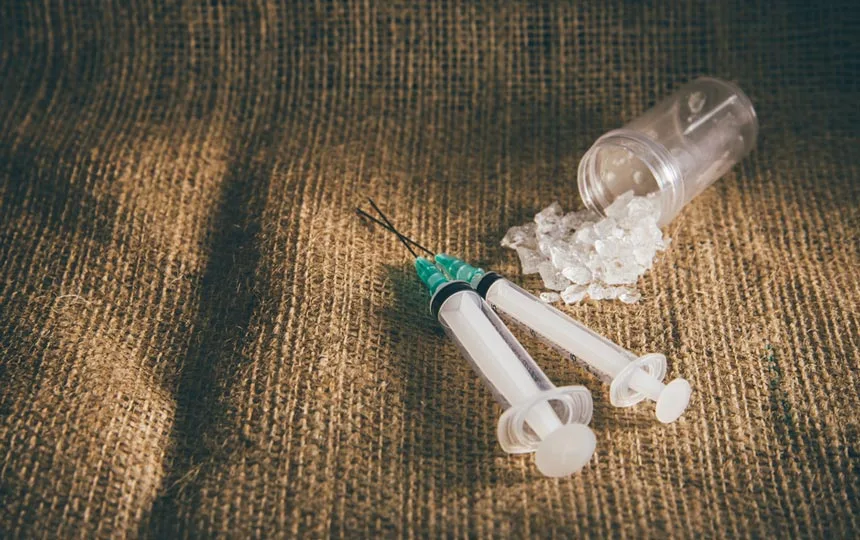How Long Do Meth Highs Last?
Table of Contents
- How Long Do Meth Highs Last?
- Factors Affecting How Long the Meth High Lasts
- Why Meth Users Keep Using
- How is Crystal Meth Used?
- What are the Side Effects of Meth Abuse?
- Recognizing the Signs of Meth Abuse and Addiction
- Meth Addiction Treatment
- Find Help to Stop Using Meth Today!
- FAQs On How Long Does a Meth High Last?
Methamphetamine, commonly known as meth, is a highly addictive stimulant drug that can lead to a range of physical and psychological effects. People who use meth typically experience a fast and intense high that can last anywhere from minutes to several hours or more. But how long does a meth high last on average?
While many people abuse this illicit drug for its euphoria-inducing effects, it is also important to recognize that this a highly dangerous substance and that the duration of the high can depend on several factors.
Keep reading to learn more about how long a meth high lasts, and how you can find effective substance abuse treatment and recovery services for yourself or a loved one today!
Factors Affecting How Long the Meth High Lasts
There are quite a few factors that can affect how long meth highs last. The amount taken, for starters, can shorten or prolong the person’s meth high. When using this drug in higher doses, individuals may experience a longer high, while smaller doses will result in a shorter high.
Additionally, a person’s method of meth use can also affect how long the high lasts. When someone smokes meth or injects meth, this produces a more intense and long-lasting high than would be produced through snorting or swallowing this drug.
A user’s metabolism will also play a role in how long the effects of meth last. People who have faster metabolisms may experience shorter highs from their drug use.
Generally speaking, a single gram of high-purity meth can keep a new user awake and feeling the effects for days, whereas a seasoned user may go through this amount in a single afternoon.
Tolerance and the Duration of a Meth High
A person’s tolerance can affect how long their meth high will last, as well. For a long-time methamphetamine user, their crystal meth high may not last as long as when they first began using this drug.
Finally, the purity of the crystal meth a person is using can also play a role in how long these meth effects will last. Meth that has been cut with other substances or otherwise low-quality crystal meth will produce a much weaker high than meth of higher purity.
Overall, these are the primary factors that shorten or lengthen the stimulant effects of methamphetamine use. Understanding these factors can help users avoid taking too much meth or continuing their use over a prolonged period of time, which can have serious adverse health effects.
Why Meth Users Keep Using
Methamphetamine is a highly addictive and dangerous drug that affects the central nervous system. As discussed, the meth high can last anywhere from several hours to a day or more and can be intensely euphoric.
Because of these intense effects, a crystal meth user may end up developing a methamphetamine addiction with repeated use. Once this addiction forms, it can be incredibly hard to stop using.
There are several reasons why people may continue their methamphetamine misuse despite its potentially dangerous side effects, including:
- Tolerance: Over time, meth users develop a tolerance to the drug, meaning they need to take more meth to get the same effects. This increased drug use can increase their risk not just of developing an addiction, but suffering an overdose as well.
- Euphoria: Meth users often experience a feeling of intense euphoria, which is a powerful high that can be difficult to let go of. Once these effects wear off, users will experience a meth crash, which can make them want to keep using.
- Addiction: Those using meth can become addicted to the drug, meaning they need to take it in order to feel “normal.” This can lead to compulsive drug use and an inability to stop without help.
- Withdrawal: If someone has developed a meth addiction, stopping their use of this drug can cause them to develop withdrawal symptoms. These can be incredibly uncomfortable to deal with and may lead to relapse if not properly managed.
How is Crystal Meth Used?

Drug abuse involving crystal methamphetamine can involve several different methods of use, each with its own side effects. It is most commonly used in a smokeable form, but can also be snorted, injected, or swallowed.
Injecting and smoking meth can create a stronger and longer-lasting high, whereas snorting or swallowing this substance will typically result in a more short-lived high. With that being said, each of these methods has its own adverse side effects and risks.
What are the Side Effects of Meth Abuse?
There are various side effects that can come with meth abuse both in the short-term and with long-term crystal meth use. It is important to remember that misusing meth even once can have severe side effects, and it is important to treat this drug with great care and discretion.
Some common short-term side effects of meth abuse include increased energy and physical activity, decreased appetite, anxiety, irritability, confusion, and insomnia. Some people may experience visual and auditory hallucinations.
A common meth hallucination is the feeling of bugs crawling on a person’s skin, also known as meth mites, which can lead to intense itching and paranoia, and even a completely psychotic state that can completely overcome a person’s senses.
Long-term abuse can lead to more severe physical effects and serious mental health consequences. These may include increased body temperature, heart rate, and increased blood pressure, as well as heart attack, stroke, and other cardiovascular issues.
It can also cause damage to a person’s brain structure, digestive system, and tooth decay, commonly known as meth mouth, when used over extended periods of time. For those who inject this drug, they may be at an increased risk of transmitting HIV, Hepatitis B, and other blood-borne infections from sharing contaminated needles.
Meth Overdose Signs and Symptoms
After the initial rush produced by this drug, many people will experience a meth comedown or crash phase, where their body responds negatively to the end of their high. This can send users into a drug binge phase, in which they take more meth to stay high.
Unfortunately, what many people do not realize is that when the drug enters their system, it can remain there longer than its high lasts. Thus, this bingeing phase and taking meth immediately after a high wears off can result in an overdose, which can be fatal.
This overdose can have both psychological and physical aspects of a meth overdose including chest pain, increased heart rate, blood pressure, body temperature, confusion, mood disturbances, psychosis, heart attack, stroke, and even death.
In addition to the various other risks of using this potent drug, overdose on meth is one of the biggest causes of concern. If you recognize any of these symptoms while you or someone else is using this drug, seek emergency medical attention immediately.
Recognizing the Signs of Meth Abuse and Addiction

Meth addiction is a serious issue that affects millions of people throughout the world, and it is important to be aware of the signs of crystal meth addiction in order to get help as soon as possible.
- Physical Signs: One of the most common physical signs of meth addiction is rapid weight loss due to the increased metabolism that is caused by the drug. Meth users might also display hyperactivity, increased heart rate, and dilated pupils. Other physical signs of meth addiction include insomnia, poor hygiene, and skin sores from excessive scratching caused by the drug’s hallucinogenic effects.
- Mental Signs: Meth addiction can cause significant changes in a person’s behavior and mental state. Common signs of meth addiction include extreme paranoia, anxiety, and panic attacks. Meth users might also experience intense mood swings, confusion, and difficulty concentrating.
- Social Signs: Meth addiction can cause significant changes in a person’s social life. Addicted individuals might display signs of isolation, as well as a lack of interest in activities they once enjoyed. Meth users are also likely to display signs of financial difficulty, as they begin to prioritize obtaining the drug over other expenses.
If you or someone you know is displaying any of the above signs of meth addiction, it is important to seek help as soon as possible. With the right support and resources, it is possible to overcome meth addiction and lead a healthy and fulfilling life.
Meth Addiction Treatment
Meth addiction treatment is a difficult process that requires a comprehensive approach to help individuals overcome their dependence on the drug. Fortunately, there are various treatment options available to help individuals struggling with meth addiction.
The first step in treating meth addiction is to get the individual into a medically-supervised detoxification program. This involves gradually reducing the amount of meth being consumed until the individual is no longer using the drug.
It is important to note that detoxing from meth can be dangerous, so it is important to be under the care of a physician during this process. Detoxing from meth can cause withdrawal symptoms, including fatigue, depression, nausea, and insomnia.
What Happens After Meth Detox?

The next step in meth addiction treatment is to get the individual into a rehabilitation program. These programs focus on helping individuals identify and address the underlying issues that led to their addiction in the first place.
This may include counseling, support groups, and job training. Rehab programs typically also offer medication-assisted treatment, which can help reduce cravings and decrease the risk of relapse.
In addition to conventional treatment programs, there are also many alternative therapies that can be used to help individuals recovering from a meth addiction. These include cognitive-behavioral therapy, motivational interviewing, and mindfulness-based therapies.
These therapies can help individuals modify their behavior and develop healthier coping strategies to deal with their addiction. Finally, it is important to note that addiction is a chronic condition that will need to be continuously managed.
This means that individuals recovering from a meth addiction will need to commit to a lifetime of abstinence and recovery. This includes attending counseling and support groups, avoiding triggers and high-risk situations, and developing a network of supportive peers.
Meth addiction is a serious problem, but it is possible to overcome. With the right treatment and support, individuals can break free from the cycle of addiction and start living healthier and more fulfilling life.
Find Help to Stop Using Meth Today!
Meth addiction can take a significant toll on the lives of yourself, your loved ones, and even your community. If you are struggling with meth abuse and want to get clean, help is available. The Find Addiction Rehabs team is available 24/7 to provide you with the tools and resources you need to start living a healthier life.
We can answer all of your treatment questions, verify your health insurance, and find treatment programs nationwide that are able to serve all of your care needs. Call now, and give yourself a chance at achieving a happy and sober life, today!
FAQs On How Long Does a Meth High Last?
How Long Does it Take to Get Addicted to Meth?
The amount of time it takes to become addicted to meth depends on many factors, including a person’s individual biology, environmental factors, and the amount and frequency of use. Generally, addiction can develop in as little as a few weeks to a few months.
How Long Does Meth Stay in the System?
How long meth will stay in your system can depend on several factors, including the amount of meth used, the user’s metabolism, and how often you use meth. Methamphetamine has a relatively short half-life, which means it is eliminated from the body relatively quickly. In general, methamphetamine will remain in the body for up to 72 hours after last use.
Will Meth Show Up On a Drug Test?
Yes, meth will show up on most drug tests. In urine tests, meth can be detected for up to four days after last use. Blood tests can detect meth for up to 24 hours after last use, and hair follicle tests can detect meth for up to 90 days after last use. Saliva tests can detect meth for up to 48 hours after last use.
Eric R. hails from Maine and does extensive work in the field of behavioral health as both a professional writer and passionate advocate for those suffering. From his own personal encounters with mental illness, he speaks to those seeking healthy relief from depression and anxiety and embraces wellness both personally and professionally. After losing friends and family to the darkness of suicide, Eric aims to educate and inform about the nature of treatment and render it accessible for all those seeking a way out of darkness and despair.

